
The other thing the Evo Lite+ offers is better low-light performance. The Air 2S has a maximum ISO of 6,400 in manual video capture, or 1,600 if you’re shooting D-log. The Evo Lite+ can shoot ISO 48,000, thanks to a dedicated Night Mode. Now, that number might sound like a recipe for noisy, mostly useless video, but surprisingly, it’s not. Autel’s Dark Mode algorithm manages relatively crisp video without scene-ruining levels of noise, even in moonlight. That said, I have never actually flown a drone at night (other than to test this feature), so how useful this is will depend a little on how you shoot.
For more general video, the Evo Lite+ is capable of shooting 5472×3076 pixel video, which is what gets labeled “6K”. For stills you can shoot 20 megapixel JPEG and RAW images. There’s also the slightly cheaper Evo Lite, which is otherwise the same, but with a smaller sensor camera that can shoot 4K, but does offer 50 megapixel stills. I haven’t tested it, but if larger-resolution still images is your primary use case, that Lite might save you some money. For most people, I’d recommend the Lite+.
The camera you shoot with isn’t the only camera that matters on a drone. The EVO Lite+ also has obstacle-avoidance sensors on the front, rear, and bottom of the drone. That mostly matches the Air 2, though DJI does have an upward-looking sensor as well, which can be important in some situations (like flying under tree branches). That said, the Evo Lite+ did a good job of avoiding everything I tried to run it into. Overall, its collision avoidance is on part with the Air 2S and should keep you out of trouble in most situations.
One thing that surprised me is that the Evo Lite+ will warn you if you’re flying somewhere you’re not supposed to—next to an airport, for example—but it doesn’t completely shut off the aircraft the way DJI does. On one hand, I applaud letting the user make their own choices, but on the other hand I’ve noticed that new drone flyers are displaying an increasing lack of awareness and common sense that is provoking a growing hostility toward drones. If people are able to fly where they shouldn’t, they will, and it won’t be long before the situation gets worse. For testing purposes I relied on the FAA’s B4UFly app (Android, iOS) to make sure I was legal to fly.
Autel also doesn’t have the AirSense alerts that DJI offers. AirSense, which first showed up in DJI drones in 2020, tracks the location of nearby manned and unmanned aircraft and alerts you if you’re near anything. I’ve never had Airsense trigger an alert about anything, but it would be nice to see something similar in Autel’s drones.
Thumb Drive

Photograph: Autel
Autel’s Sky app for iOS and Android is very similar to DJI’s apps and is intuitive and easy to use. The controller, I was less thrilled with. It looks like an Xbox controller, which is fine, but it lacks any storage space for the removable joysticks, like you get with DJI drones. Worse, Autel doesn’t provide an extra joystick like DJI does.
That said, the controller is easy to use and I had no trouble flying. When you take off for the first time, the Sky app will put you in a beginner mode that limits speed and altitude. I suggest staying in this mode until you get comfortable. The Evo Lite+ is maybe slightly less responsive than the DJI Air 2S, due to the extra weight, but the weight is an advantage in the wind, which I dealt with a lot when testing.
The Sky app offers a variety of flight modes, including Smooth, Standard, and Ludicrous. The latter enables a top speed of 42 miles an hour and more or less negates the obstacle-avoidance features, since you’re not going to have time to react to any warning. But it’s fun to fly in Ludicrous mode.
Overall, the Autel Evo Lite+ is the first drone I’ve tested that holds its own against DJI’s very impressive offerings. If you want the control of a variable aperture camera, along with the increased flight time, and don’t mind the slightly higher price, the Autel Evo Lite+ trumps the DJI Air 2S.
